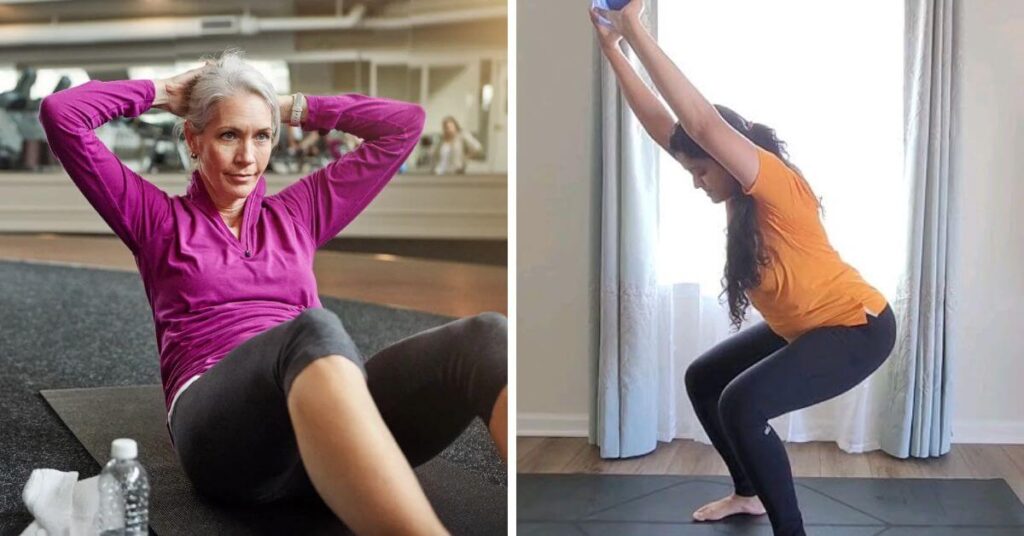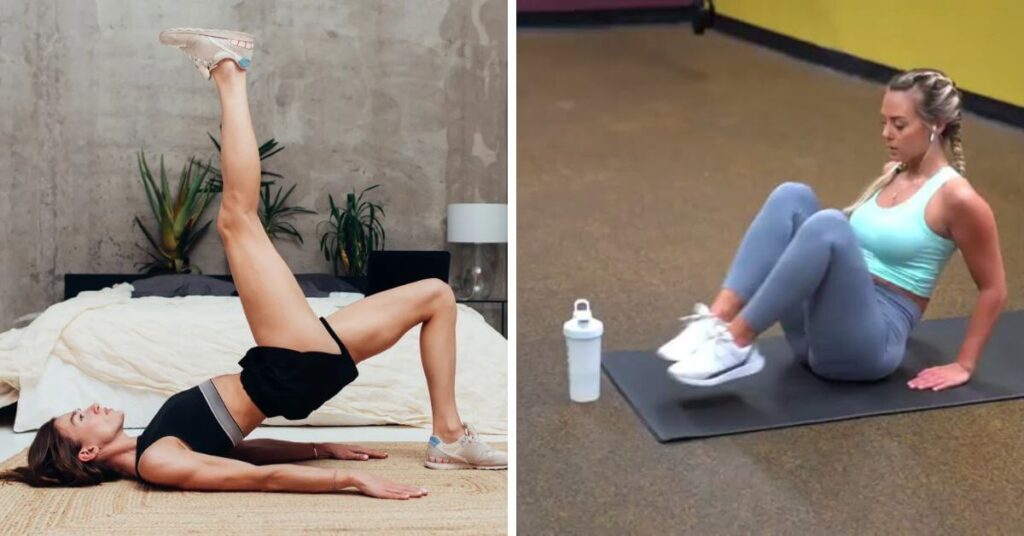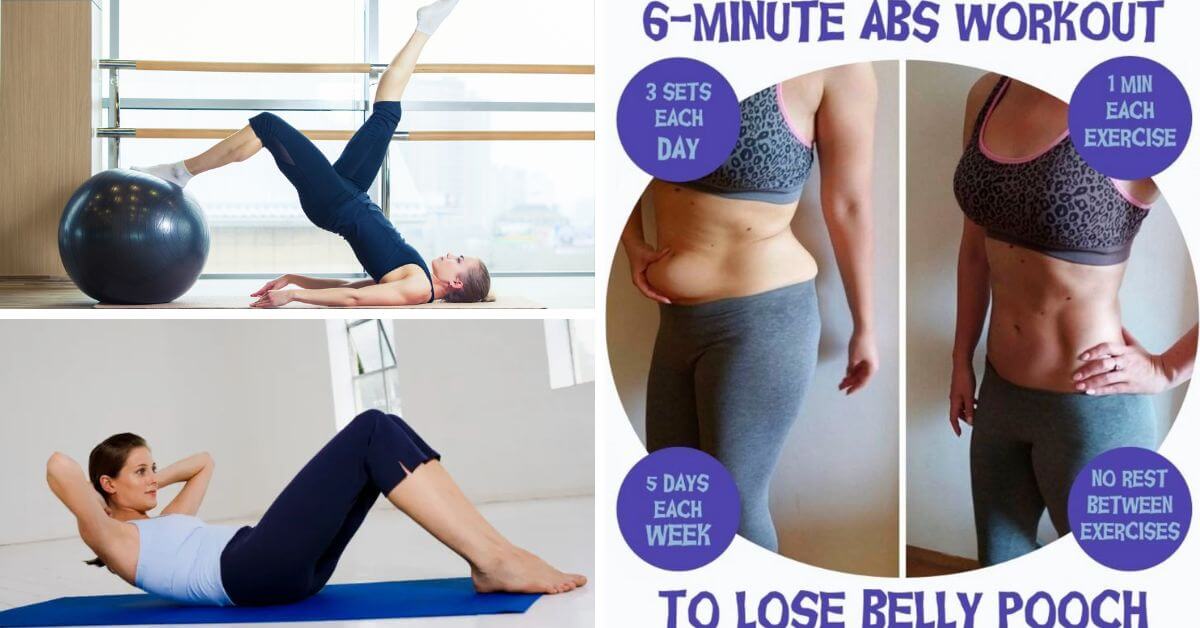Struggling with that stubborn lower belly bulge? Pooch Belly Exercises offer a targeted and effective way to tighten your core, strengthen your posture, and boost your overall confidence. Unlike fad fixes or empty crunches, these science-backed workouts focus on activating your transverse abdominis, obliques, and deep core stabilizers the muscles that truly flatten the belly from within.
What is a Pooch Belly and Why It Happens
A pooch belly workout is that soft, protruding area of the lower abdomen typically located just below the belly button. It’s common, frustrating, and often misunderstood. While many people assume it’s just fat, the truth goes much deeper. Literally.
So, What Causes a Pooch Belly?
Let’s break it down with a blend of biology, lifestyle science, and real-world reasons:
1. Weak Deep Core Muscles
At the root of many pooch bellies is a weakened transverse abdominis (TVA) the deep muscle that acts like a built-in corset. When this muscle loses strength or control, your internal organs and soft tissues aren’t held in as tightly, making your belly appear rounded or bloated even without excess fat.
2. Post-Pregnancy Changes
During pregnancy, abdominal muscles and connective tissues stretch, sometimes even separating (diastasis recti). After birth, if these muscles don’t heal and engage properly, they leave a lingering “mummy pooch” even years later.
3. Poor Posture & Sedentary Lifestyle
Hours of sitting (desk jobs, driving, binge-watching) lead to tight hip flexors, weak glutes, and anterior pelvic tilt. This tilts your pelvis forward, pushes the stomach outward, and creates the illusion of a pooch belly workout even if your weight is normal.
4. Excess Belly Fat (Especially Visceral Fat)
Visceral fat wraps around your internal organs. It’s hormonally active and dangerous in high amounts. Unlike subcutaneous fat (the pinchable kind), visceral fat pushes your belly outward from the inside, contributing to that pooch effect and increasing health risks.
5. Chronic Stress & Cortisol Overload
Stress raises cortisol, a hormone that tells your body to store fat especially in the belly. Add poor sleep to the mix, and you’ve got a hormonal environment that practically guarantees a lower belly bulge.
6. Hormonal Shifts (Especially in Women)
Estrogen, progesterone, and insulin resistance during perimenopause or menopause can all contribute to stubborn belly fat and muscle loss around the core. Your metabolism slows, and fat is more likely to settle around the abdomen.
Why Do You Need Pooch Belly Exercises?
If you’ve ever looked in the mirror and wondered why that lower belly bulge just won’t go away despite eating clean or hitting the gym you’re not alone. The “pooch” belly is one of the most common (and most stubborn) areas of concern, especially for women, postpartum bodies, desk workers, and aging adults.
Here’s why Pooch Belly Exercises are essential:
1. The Pooch Isn’t Just Fat – It’s Often Weak Core Muscles
That soft curve below your belly button is often caused by underactive deep core muscles especially the transverse abdominis (TVA). This internal muscle acts like a corset, holding in your organs and supporting your spine. When it’s weak, your belly pushes forward, creating that “pooch” look even if you’re not overweight.
2. Lower Belly Pooch Can Worsen with Poor Posture and Sedentary Life
Sitting all day, slouching, and not engaging your core tightens your hip flexors and tilts your pelvis forward, exaggerating the lower belly. Pooch belly exercises realign your core and improve posture, reducing that droop.
3. Postpartum Recovery Depends on Rebuilding Core Strength
Pregnancy stretches and sometimes separates abdominal muscles (diastasis recti). Pooch belly exercises can safely rebuild the core, especially when focusing on TVA engagement, gentle activation, and posture realignment.
4. You Can’t Spot-Reduce Fat, But You Can Target Weak Areas
Crunches alone won’t shrink belly fat. But combining pooch-targeted exercises with cardio, proper nutrition, and total-body movement helps you flatten and tighten the belly as fat melts off systemically.
5. It’s Not Just Aesthetic It’s About Health
Excess belly fat (especially visceral fat) is linked to higher risks of heart disease, diabetes, and hormonal imbalances. A strong core improves digestion, circulation, and even breathing.
6. Mental Confidence and Physical Control
When you train your core properly, you feel it your posture improves, your clothes fit better, and your confidence rises. Plus, it makes every other workout safer and more effective.
The Science: Why Spot Reduction Doesn’t Work Alone
You’ve probably heard it or hoped it was true: “Do crunches and you’ll burn belly fat.” Unfortunately, that’s a common myth. The concept of spot reduction the idea that you can lose fat from a specific body part by targeting it with exercises has been debunked by science over and over again.
Let’s break it down.
What Is Spot Reduction and Why It’s Misleading
Spot reduction assumes that fat loss can be localized. For example, if you do hundreds of crunches, you’ll lose fat only around your stomach.
But fat loss doesn’t work that way. Your body doesn’t pick and choose where to burn fat based on which muscles you’re training. Instead, fat loss is systemic your body draws energy from fat stores throughout the body, not just from the area being worked.
What Science Tells Us
Multiple studies have confirmed the truth:
- A 2011 study published in the Journal of Strength and Conditioning Research found that six weeks of abdominal exercises increased muscular endurance but did not reduce abdominal fat.
- In another controlled study, researchers had participants train only one leg with resistance exercises. Fat loss occurred evenly on both legs not just the one being trained.
Conclusion: You can strengthen a specific muscle, but you can’t burn fat in that area alone. Strength training doesn’t burn fat locally; it builds muscle. Fat loss requires a caloric deficit and whole-body effort.
So What Actually Works for Belly Fat?
To lose the pooch, you need a comprehensive approach:
- Pooch Belly Exercises: Strengthen the deep abdominal muscles like the transverse abdominis (TVA), rectus abdominis, and obliques.
- Full-body Cardio or HIIT: These workouts burn calories efficiently, reduce overall fat, and help shrink visceral belly fat.
- Strength Training: Building lean muscle increases metabolism, helping your body burn more calories even at rest.
- Clean, Balanced Nutrition: Consuming fewer calories than you burn while still fueling your body with nutrients is essential for fat loss.
- Lifestyle Tweaks: Managing stress, getting good sleep, and reducing cortisol all help prevent excess fat storage, especially around the abdomen.
Core Anatomy 101: Belly Pooch, Explained
If you want to get rid of your lower belly pooch, you first need to understand what’s going on under the surface. The core isn’t just about “six-pack abs” it’s a complex network of muscles that work together to stabilize your spine, protect your organs, and support your posture.
Here’s a clear, science-backed look at the muscles involved in belly pooch and why strengthening them is key to flattening your tummy.
What Is the Core, Really?
Your core includes more than just your front abs. It’s a 360-degree system of muscles wrapping around your torso like a natural corset. The most important players when it comes to belly pooch Tips are:
🔹 1. Transverse Abdominis (TVA) – The Deep Stabilizer
- Think of the TVA as your natural waist trainer.
- It’s the deepest abdominal muscle running horizontally across your abdomen like a belt.
- When it’s strong and active, it pulls your stomach in flat, supports your spine, and stabilizes your pelvis.
- Weak TVA = belly pooch that pushes outward.
👉 TVA-focused exercises like Pilates, vacuum breathing, and dead bug drills help “flatten” the tummy from the inside out.
🔹 2. Rectus Abdominis – The Six-Pack Muscle
- This is the most visible ab muscle and the one most people try to target with crunches.
- It runs vertically from your ribs to your pelvis.
- Its main function is to flex the spine (like when you sit up or crunch).
- While important, focusing only on this muscle can actually lead to a bulging belly if deeper core muscles are neglected.
👉 Crunches can tone the rectus, but won’t fix the pooch unless the TVA and posture are addressed too.

🔹 3. Internal & External Obliques – The Waist Shapers
- These muscles are located on the sides of your abdomen.
- They help with twisting, bending, and side flexion plus they assist with core stabilization.
- Strong obliques contribute to a smaller, cinched-in waist and help control side-bulging fat.
👉 Russian twists, side planks, and heel touches are great for oblique engagement.
🔹 4. Pelvic Floor Muscles & Multifidus – The Hidden Heroes
- Often overlooked, these muscles play a crucial role in core control, posture, and stability.
- Weak pelvic floor muscles (especially postpartum) can lead to core dysfunction and contribute to lower belly bulging.
- The multifidus, a group of small muscles along your spine, keeps your back stable important for safe abdominal training.
So Why Do These Muscles Matter for the Lower Belly Pooch?
When any of these core muscles especially the TVA are underused or weakened, your abdominal wall loses tension. The result?
- A protruding belly (even if you’re not overweight)
- Poor posture that makes the pooch more visible
- Instability in your spine, hips, and pelvis
- Ineffective workouts, since you’re not engaging your core properly
✅ The Fix: Train Your Core Smarter
Don’t just do crunches. Instead, focus on pooch belly exercises that:
- Activate your transverse abdominis
- Strengthen your entire core unit
- Improve posture and spinal alignment
- Combine with cardio and nutrition for fat loss
Best Women Health Supplements:

- Balances Female Hormones
- Strengthens Pelvic and Bladder Function
- Supports the Urinary Microbiome
- Fast-Acting Yet Long-Lasting Support


- Promotes Hormonal Balance
- Reduces Hot Flushes and Night Sweats
- Eases Anxiety and Stress
- Supports Healthy Weight Management
Top 5 Pooch Belly Exercises That Actually Work
When it comes to flattening your lower belly pooch, not all ab workouts are created equal. Forget endless crunches what you need are smart, strategic exercises that target the deep core muscles, especially the transverse abdominis (TVA), and stabilize your pelvis.
Below are the top 5 pooch belly exercises that are scientifically backed, beginner-friendly, and can be done at home or the gym no fancy equipment needed.
✅ 1. Dead Bug with Belly Bracing
Best for: Activating your deep core (TVA) and improving spinal control
How to do it:
- Lie on your back with your arms straight up and knees bent at 90 degrees.
- Inhale deeply, then exhale while pulling your belly button toward your spine (belly bracing).
- Slowly lower your right arm and left leg toward the ground while keeping your core tight.
- Return to the start and switch sides.
Reps: 3 sets of 8–10 reps per side
👉 Why it works: It strengthens the TVA, improves coordination, and keeps your back supported.
✅ 2. Reverse Leg Slides with Core Activation
Best for: Flattening the belly and engaging the lower abs
How to do it:
- Lie on your back, knees bent, feet flat.
- Tighten your core (pull belly button in without holding your breath).
- Slowly slide one foot forward, keeping it in contact with the floor.
- Bring it back and switch legs.
Reps: 3 sets of 10–12 reps per leg
👉 Why it works: It’s gentle yet deeply effective for activating the TVA without straining the spine.
✅ 3. Side Plank Hip Lifts
Best for: Tightening the waist and toning the obliques
How to do it:
- Lie on one side, forearm on the ground, elbow under shoulder, legs straight.
- Lift your hips off the ground into a straight side plank.
- Lower your hips slightly without touching the floor, then lift back up.
Reps: 3 sets of 12–15 reps per side
👉 Why it works: Strengthens the obliques and TVA while improving lateral stability and posture.
✅ 4. Heel Touches (Oblique Crunches)
Best for: Sculpting your waist and tightening side fat
How to do it:
- Lie on your back, knees bent, feet flat on the floor.
- Lift your shoulders off the ground slightly.
- Reach your right hand to touch your right heel, then your left hand to your left heel side to side.
Reps: 3 sets of 20–30 touches
👉 Why it works: This move targets your obliques, increasing side contraction and improving definition in your waistline.
✅ 5. Leg Raises with Posterior Pelvic Tilt
Best for: Activating lower abs and reducing anterior pelvic tilt
How to do it:
- Lie flat with arms by your sides, legs extended.
- Tighten your core and gently press your lower back into the floor.
- Raise both legs to a 90-degree angle, then slowly lower them just above the floor while maintaining a flat lower back.
Reps: 3 sets of 8–10 reps
👉 Why it works: Targets the lower rectus abdominis and forces you to engage your entire core to keep your pelvis in place.
Tip: Focus on Breathing & Form
- Always exhale during effort (e.g., lifting or bracing) and inhale during release.
- Keep your movements slow and controlled to fully activate the core muscles especially the TVA.
- Do not let your lower back arch. This takes the pressure off your belly and places it on your spine.
Strategy: Nutrition, Sleep & Lifestyle
Pooch belly exercises alone won’t flatten your tummy if what’s happening outside the gym is working against you. The truth is: your lower belly responds just as much to your lifestyle choices as to your workouts.
let’s cover the powerful pillars nutrition, sleep, and daily habits that support a flatter, stronger, and healthier core.
1. Nutrition: Eat for a Leaner, Less Bloated Belly
What you eat can either shrink or feed your lower belly pooch. Exercise may sculpt the muscles, but nutrition is what reveals them.
✅ Focus on These Foods:
- High-fiber vegetables: Broccoli, spinach, kale, and zucchini keep you full and reduce bloating.
- Lean proteins: Chicken breast, tofu, Greek yogurt, and lentils fuel muscle repair and reduce fat storage.
- Healthy fats: Avocados, nuts, seeds, and olive oil help regulate hormones and fight belly fat.
- Whole grains (in moderation): Quinoa, oats, and brown rice offer energy and gut health support.
❌ Avoid These Belly Bloaters:
- Refined carbs: White bread, pastries, and sugar spike insulin and store more fat.
- Carbonated drinks: Soda and sparkling water can lead to gas and bloating.
- Artificial sweeteners: Often cause water retention and gut irritation.
- Processed snacks: Chips, fast food, and fried foods promote inflammation and belly fat buildup.
Tip:
Drink at least 2–3 liters of water per day. Staying hydrated reduces bloating, aids digestion, and supports fat metabolism.
2. Sleep: The Missing Piece in Your Belly Fat Puzzle
Sleep isn’t just about rest it’s a major metabolic regulator. Getting quality sleep directly impacts your weight, hormone levels, and core recovery.
Here’s What Happens When You Don’t Sleep Enough:
- Cortisol spikes: This stress hormone promotes fat storage, especially around the belly.
- Hunger hormones go haywire: Lack of sleep increases ghrelin (your hunger hormone) and decreases leptin (your satiety hormone).
- Insulin resistance rises: Poor sleep reduces your ability to metabolize carbs, leading to belly fat gain.
✅ Sleep Tips for a Flatter Belly:
- Aim for 7–9 hours of quality sleep each night.
- Stick to a consistent bedtime and wake-up schedule even on weekends.
- Avoid screens 1 hour before bed to improve melatonin production.
- Limit caffeine after 2 PM and alcohol before bedtime.
- Try magnesium or calming teas (chamomile, lemon balm) to aid natural sleep.
3. Lifestyle: Habits That Support a Stronger Core
If you’re doing all the right workouts but still carry belly pooch, your daily habits could be sabotaging you.
A. Manage Stress Like a Pro
Chronic stress = chronic cortisol = persistent lower belly fat.
Try:
- Deep breathing or box breathing (inhale 4s, hold 4s, exhale 4s)
- Yoga or light stretching
- Journaling or mindfulness meditation (even 5 minutes helps)
- Walks in nature (known to reduce cortisol)
B. Stay Consistently Active
Even if you’re not working out, non-exercise movement matters.
Try:
- 10,000 steps a day
- Standing or walking meetings
- Cleaning, gardening, or dancing
It all adds up and helps burn calories and regulate insulin.
C. Fix Your Posture
Poor posture pushes your belly outward.
To improve it:
- Practice pelvic tilts and glute activation
- Sit with your spine tall and shoulders relaxed
- Use posture-supporting tools (lumbar pillows, standing desks)
D. Avoid Tight Clothing
Believe it or not, wearing tight waistbands or shapewear 24/7 can actually weaken your core muscles over time. Give your stomach room to breathe and function naturally.

Sample Weekly Pooch-Belly Plan
Ready to tighten your core and flatten that stubborn belly pooch? This 7-day pooch-belly plan combines targeted core exercises, full-body movement, and healthy habits to help you burn fat, build strength, and feel confident in your skin.
Whether you’re just starting or getting back on track, this weekly routine is balanced, beginner-friendly, and results-driven no gym membership needed!
Weekly Overview
| Day | Focus Area | Duration | Equipment |
|---|---|---|---|
| Monday | Deep Core + Cardio Boost | 30–40 min | Mat + Light Weights (optional) |
| Tuesday | Strength Training + TVA Work | 30 min | Bodyweight/Dumbbells |
| Wednesday | Active Recovery + Obliques | 20–30 min | Mat |
| Thursday | HIIT + Pooch Circuit | 30–35 min | Bodyweight |
| Friday | Full-Body Strength + Abs | 35–45 min | Dumbbells (optional) |
| Saturday | Stretch + Posture Reset | 15–20 min | Yoga Mat |
| Sunday | Rest + Mindful Meal Prep | — | — |
Day-by-Day Breakdown
🟢 Monday: Deep Core Activation + Light Cardio
- Warm-up (5 min): March in place, arm circles, toe touches
- Workout
- Dead Bug – 3 sets of 10 reps
- Leg Slides – 3 sets of 12 reps per leg
- Reverse Crunches – 3 sets of 15
- Jumping jacks or brisk walk – 15 min
- Cool down (5 min): Gentle hip flexor and back stretches
👉 Focus: Strengthen deep abdominal muscles (TVA) and lightly burn calories
🔵 Tuesday: Total Body Strength + TVA Work
- Warm-up (5 min)
- Workout
- Bodyweight Squats – 3 sets of 15
- Glute Bridges – 3 sets of 20
- Plank with Shoulder Taps – 3 sets of 30 sec
- Diaphragmatic Breathing – 3 sets of 10 deep breaths
- Side Plank Hip Lifts – 3 sets of 10 per side
- Cooldown: Stretch hamstrings and back
👉 Focus: Engage core while building lean muscle to boost fat burn
🟡 Wednesday: Active Recovery + Oblique Toning
- Activity:
- Walk outdoors for 20–30 min OR
- Light yoga/stretch session
- Core work (optional):
- Heel Touches – 3 sets of 20
- Russian Twists – 3 sets of 25
- Cat-Cow & Pelvic Tilts – 2 rounds
👉 Focus: Loosen tight muscles and gently tone your waist
🔴 Thursday: HIIT + Core Burn
- Warm-up (5 min)
- Circuit (Repeat 3x)
- 40 sec Mountain Climbers
- 40 sec Bicycle Crunches
- 40 sec Leg Raises
- 40 sec Rest
- Finisher
- Plank – Hold 60 seconds
- Side Plank – 30 sec each side
- Cooldown: Stretch quads, hips, and lower back
👉 Focus: Burn fat, boost metabolism, and target stubborn belly fat
⚫ Friday: Strength + Abs Focus
- Strength Moves
- Reverse Lunges – 3×12 per leg
- Bent-Over Rows – 3×15
- Push-Ups – 3×10 (knees OK)
- Core Burnout
- Leg Lifts with Posterior Pelvic Tilt – 3×10
- Side Plank Twists – 3×10
- Boat Hold – Hold 30 seconds x 2
👉 Focus: Build full-body strength and firm your midsection
🟣 Saturday: Posture + Flexibility Reset
- Yoga or Mobility Flow (15–20 min)
- Cat-Cow
- Child’s Pose
- Cobra Stretch
- Supine Twist
- Seated Forward Fold
- Standing Posture Check-In
👉 Focus: Restore balance, improve posture, and release tension that causes core weakness
🟤 Sunday: Rest + Reset
- Plan meals for the week
- Hydrate intentionally
- Practice mindful eating
- Self-care: Journaling, reading, or nature walk
- Optional: 10-min guided meditation or breathwork for stress reduction
👉 Focus: Rejuvenate mentally and physically for the upcoming week
Additional Tips for Success
- Stick with it for 4–6 weeks to notice visible changes
- Track your sleep, hydration, and nutrition daily
- Progress slowly form matters more than reps
- Celebrate wins like improved posture, endurance, and energy








